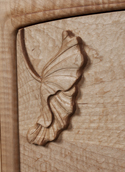Mahogany Drop Leaf Table
I was one of six furniture designers/makers selected to contribute to an exhibition in the Center for Furniture Craftsmanship, Rockport, Maine. The theme was "Setting the Table", and each furniture maker was assigned to a team that included an interior design firm, and an art gallery. Each group was to collaborate on a finished vignette; a dinner set in a room-like environment, complete with table and two chairs, art work, carpets, and table ware.
I was fortunate that my collaborators were The Gallery at Frenchman's Bay and Margo Moore Interiors, both well-established Maine firms. Our initial meetings during the winter months were wonderfully creative, interactive and far-reaching in scope. As summer approached, we all became very busy with our individual clients, and interactions less frequent.
Having recently spent time with urban clients who bemoaned the lack of space for a 'real' dining room, I thought this was the time to revisit the functionality of the drop-leaf form. As a result, I scaled back the original concept in favor of this drop-leaf table with shaped and carved legs and edge moldings. The chairs themselves have extensive shaping and carving, as well as steam-bent stretchers and supple leather upholstery. In all, I appreciated the opportunity to explore the drop-leaf form, to work with our dear collaborators, and to experience the shared opportunities that this exhibition offered.
More Images

